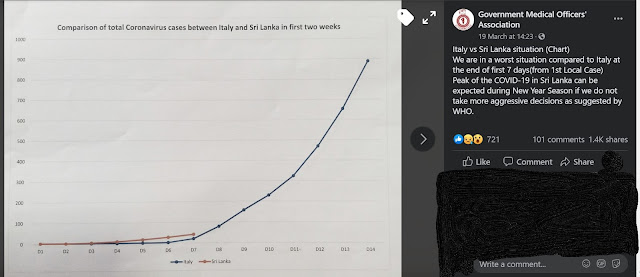Coronavirus: Lockdown Exit Strategy - Key Questions
It is clear that the government
has so far been highly successful in managing the spread of the corona virus.
The low number of cases and deaths, even accounting for population size, are
evidence of that. It's possible that the real number of cases is higher due to
insufficient testing or due to asymptomatic cases. However, it is unlikely that
deaths will go unrecorded. So far we have seen only 5 deaths which is the same
as Taiwan (with a similar population size as SL) which is widely considered a
model case of successful management of this pandemic. Therefore, it is fair to
say that, from a pandemic control point of view up to now, the government has
got its early decisions right and has handled an unprecedented crisis much
better than the vast majority of countries. A survey
done by Verite Research suggests high public satisfaction with the government
response
What is the
exit strategy for the curfew and lockdown?
While the lockdown measures currently in place
have undoubtedly helped control the pandemic, it is obvious that it is not
sustainable for very long. A plan to gradually ease restrictions is
required as also pointed out by a group of senior medical professional and
Chair Professors of Medicine. The attention of several
governments has now turned towards determining an exit strategy
for lockdowns, where countries can return to a level of normal economic
activity while managing the pandemic. A recent New York Times article
makes the case for a highly proactive and targeted system of repeated cycles of lockdowns based on
very robust monitoring [source: https://www.nytimes.com/2020/04/06/opinion/coronavirus-end-social-distancing.html]. While no-one knows yet for certain what
the correct approach will be, there is widespread agreement on a few key
points:- It is no longer possible to contain or eradicate the virus unless a vaccine is developed and made widely available (at least an year away according to most reports)
- The objective is to 'flatten the curve' i.e. spread the infection as much as possible over time so that hospitals are not overwhelmed
- Every country will have to adopt a strategy that is best suited for its own resources and other circumstances
- The success of any exit strategy will depend on a very robust system of testing and monitoring which can quickly identify potential virus hot spots
Sri Lanka has so far carried out approximately 3200
tests (150 per 1Mn people) which is a very low number. The current testing
frequency is approx. 200 per day. In contrast, Singapore &
Hong Kong, two countries with robust monitoring systems, have carried out
10,000 tests per 1Mn population [source: worldometers.info]. There are reports that the full
testing capacity within the country is not being utilized and
also that some test kits brought down are faulty. In any case,
there's no doubt that testing has to be significantly ramped up before any lock down exit strategy can be put in place. So far there has been no indication of
any plan to that end, given by any related authority.
What is the
medical body with authority?
For any future strategy to be successful, it is
absolutely vital that expert medical advice, relevant to this particular
area of medicine, is taken in to consideration. Right now there are
several parties issuing reports and advisories - Ministry of Health, Dept
of Epidomiology, GMOA, individual and other groups of doctors.
This is confusing for the public as well as the other authorities. It
would be best if a panel of medical experts is publicly appointed and
given the sole authority on decision making and public reporting on the
medical aspects. In the absence of such a body, the GMOA in particular
seems to be even going beyond its scope in trying to take a very public
role in influencing the government response, despite having no particular
expertise on this subject which has actually led some doctors to speak out
against it.

Comments
Post a Comment